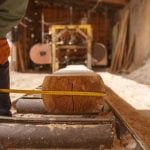Woodworking clamps are an essential tool in any woodworker’s arsenal, providing the necessary pressure and support to hold pieces of wood together during the gluing or assembly process. These versatile tools come in a variety of types such as bar clamps, C-clamps, pipe clamps, and more, each with its own unique application in woodworking projects.
In this article, we will explore how to build woodworking clamps from scratch, covering everything from understanding the mechanics of woodworking clamps to gathering supplies and materials.
Understanding the mechanics of woodworking clamps is crucial for anyone looking to build their own. By exploring the basic components and functions of different types of clamps, woodworkers can gain a deeper insight into how these tools operate. Additionally, having a good grasp of the mechanics behind woodworking clamps is beneficial for customizing or creating advanced clamp designs.
To embark on the journey of building woodworking clamps, it is essential to gather all the necessary supplies and materials beforehand. This includes but is not limited to wood for the clamp bodies, screws or bolts for adjusting the clamp pressure, and rubber pads for protecting delicate surfaces. Knowing where to source these materials – whether from hardware stores or online suppliers – is also crucial in ensuring a smooth building process.
Understanding the Mechanics of Woodworking Clamps
Basic Components of Woodworking Clamps
Woodworking clamps are essential tools for holding pieces of wood securely in place during a project. These clamps typically consist of various components, including the handle, screw, jaw, and pad. The handle is used to tighten and release the clamp, while the screw allows for adjustment of the jaw’s position. The jaw is the part of the clamp that exerts pressure on the workpiece, and the pad provides a gripping surface to prevent damage to the wood.
Functionality of Different Types of Woodworking Clamps
There are several types of woodworking clamps, each designed for specific applications. For example, bar clamps are ideal for larger projects and offer versatile functionality due to their long reach. C-clamps are commonly used for light-duty tasks and can be easily adjusted by hand.
Parallel clamps provide even pressure along the entire length of a workpiece and are often used for cabinet making. Understanding how each type of woodworking clamp functions will help woodworkers choose the right tool for their project.
Choosing the Right Clamp for Your Project
When it comes to choosing woodworking clamps, it’s important to consider factors such as the size and shape of the workpieces, as well as the specific woodworking techniques being employed. For instance, edge clamps are suitable for joining pieces at 90-degree angles, while pipe clamps are excellent for applying pressure across wider surfaces. By understanding how different types of woodworking clamps function, woodworkers can select the most appropriate clamp for their particular project needs.
Building high-quality woodworking clamps at home requires careful craftsmanship and attention to detail. From gathering supplies and materials to understanding the mechanics behind these essential tools – accomplished through many different parts down to some simple items commonly found in households – building these devices requires more than just time but also dedication towards embracing creativity steeped in technical know-how related to woodworking orientations inclining some artistic twists not solely concentrated on conventional methods.
Gathering Supplies and Materials
When it comes to building woodworking clamps, having the right supplies and materials is crucial to ensure that the clamps are durable and effective. To get started, you will need the following materials: hardwood or softwood lumber, steel rods, screws, washers, and T-nuts.
The type of wood you choose will depend on personal preference and the intended use of the clamp. Hardwood such as oak or maple is often preferred for its strength and durability, while softwood like pine may be suitable for lighter duty clamps.
In addition to the wood and metal components, you will also need woodworking tools such as a saw, drill press, chisel, file, and sandpaper. These tools will be essential for shaping and assembling the various parts of the woodworking clamps. When it comes to sourcing the materials, you can either purchase them from a hardware store or lumberyard, or repurpose items from around your workshop. For example, old furniture or scrap wood may be suitable for constructing woodworking clamps.
It’s important to note that the quality of your woodworking clamps will largely depend on the quality of materials used. Therefore, it is recommended to invest in high-quality lumber and metal hardware to ensure that your clamps are sturdy and long-lasting. In the next section, we will delve into a step-by-step guide on how to build a basic woodworking clamp using these supplies and materials.
Step-by-Step Guide to Building a Basic Woodworking Clamp
Woodworking clamps are essential tools for any woodworking project, as they help to hold pieces of wood securely in place while glue dries or while working with power tools. There are different types of woodworking clamps, including bar clamps, pipe clamps, and C-clamps, each serving a specific purpose. For woodworkers interested in creating their own woodworking clamps, it is important to understand the mechanics of these tools and gather the necessary supplies and materials.
Gathering Supplies and Materials
Before embarking on the construction of woodworking clamps, gather the following supplies and materials:
- Hardwood for the jaws and handle
- Metal rods or pipes for the bar portion
- Wood screws or dowels
- Nuts, bolts, and washers
- Wood glue
- Varnish or sealant
These supplies can be sourced from local hardware stores or specialty woodworking shops. Consider using high-quality hardwood such as maple or oak for durability and strength. Additionally, ensure that the metal rods or pipes are sturdy enough to withstand pressure when clamping.
It is important to have a clear understanding of how to build woodworking clamps before starting the construction process. Below is a step-by-step guide on building a basic woodworking clamp from scratch:
- Measure and cut the hardwood to create the jaws of the clamp.
- Drill holes in the jaws for inserting the metal rods or pipes.
- Cut the metal rods or pipes to size using a hacksaw.
- Attach one end of each rod or pipe to one jaw using nuts, bolts, and washers.
- Create a handle from hardwood and attach it to one end of the clamp using wood screws or dowels.
- Apply wood glue at all joints for added strength.
- Finally, sand down any rough edges and apply varnish or sealant for a polished finish.
This simple yet effective woodworking clamp can be used for various projects in the workshop with ease. However, it is essential to practice caution when using these homemade clamps to ensure safety during woodworking tasks.
By following this step-by-step guide on building basic woodworking clamps, woodworkers can gain valuable experience in crafting their own tools while also saving money on purchasing commercially-available options. With patience and precision, anyone can create functional clamps that meet their specific needs.
Advanced Woodworking Clamp Designs
Introduction to Advanced Woodworking Clamp Designs
As woodworkers become more experienced, there is often a need for more specialized clamps to tackle complex and unique projects. Advanced woodworking clamp designs offer increased versatility and precision, allowing for the successful completion of intricate woodworking tasks. These clamps are specifically engineered to handle non-standard shapes and materials, providing woodworkers with the ability to work on a wide range of projects with confidence.
Tools and Techniques Required
Building advanced woodworking clamps requires a higher level of skill, as well as the use of additional tools and techniques. In addition to the basic tools needed for building traditional clamps, advanced designs may require the use of specialized cutting tools, drill presses, or even welding equipment. Furthermore, woodworkers may need to learn advanced joinery or metalworking techniques in order to assemble these intricate clamp designs.
Examples of Advanced Woodworking Clamp Designs
One example of an advanced woodworking clamp is the parallel jaw clamp, which features jaws that remain parallel during clamping, providing consistent pressure along the entire length of the workpiece. Another example is the edge banding clamp, which is designed specifically for applying veneer or edge banding to narrow edges.
Additionally, pipe clamps are versatile tools that can be utilized in diverse ways due to their adjustable design. These are just a few examples of advanced woodworking clamp designs that cater to specific needs and demands of complex woodworking projects.
By familiarizing themselves with these types of clamps and mastering the required skills, woodworkers are equipped with essential knowledge that will enable them to tackle even the most challenging tasks.
Tips for Customizing Woodworking Clamps
Customizing woodworking clamps to fit specific project needs is an essential skill for woodworkers. Whether you need a larger clamp, a longer reach, or a different type of grip, being able to modify your clamps will make your work easier and more efficient. There are several ways to customize woodworking clamps, and understanding these options can greatly enhance the versatility of your clamps.
One way to customize woodworking clamps is by altering the size or shape of the jaws. This can be as simple as adding padding to protect delicate materials or as complex as creating custom jaw shapes for unique project requirements. Understanding how to remove and reattach the jaws on your clamps is crucial for this type of customization.
Another method for customizing woodworking clamps is by modifying the handles. Some woodworkers prefer longer handles or different grip styles for added comfort and control. It’s important to consider ergonomics when customizing clamp handles, as they play a significant role in ease of use during long hours of woodworking.
In addition to jaw and handle modifications, some woodworkers choose to add accessories such as pivot pads or stop blocks to their clamps. These additions can improve the functionality of the clamp for specific tasks and help prevent damage to both the workpiece and the clamp itself.
Understanding how accessories can be integrated into woodworking clamps will allow you to tailor them more precisely to each unique project. Learning how to build woodworking clamps is just the beginning; mastering customization techniques will take your woodworking skills to the next level.
Maintenance and Care of Woodworking Clamps
Woodworking clamps are essential tools in any woodworking project as they help hold pieces of wood together while the glue dries, ensuring a strong and secure bond. Proper maintenance and care of woodworking clamps are crucial to ensure their longevity and reliable performance. By taking the time to clean, lubricate, and store your clamps properly, you can extend their lifespan and maintain their effectiveness.
One important aspect of caring for woodworking clamps is keeping them clean. Sawdust, glue residue, and other debris can build up on the clamp surfaces over time, affecting their grip and maneuverability. Regularly wipe down your clamps with a clean cloth or brush to remove any accumulated dirt. For stubborn residue, use a mild solvent or cleaner to dissolve the buildup without damaging the clamp’s components.
In addition to cleaning, lubrication is another key element in maintaining woodworking clamps. Lubricating the moving parts of the clamps will help them operate smoothly and prevent corrosion.
Apply a light coat of oil or silicone-based lubricant to the screws, threads, and pivot points of your clamps to keep them in good working condition. It’s important to avoid using heavy grease or lubricants that can attract dust and debris, which may impede the function of the clamps over time.
Finally, proper storage is essential for preserving woodworking clamps when they are not in use. Store your clamps in a dry area away from moisture and extreme temperatures to prevent rusting or warping. Hanging your clamps on a rack or storing them in a designated case can protect them from damage and make them easily accessible when needed.
| Maintenance Tips | Care Strategies |
|---|---|
| Regularly wipe down with clean cloth | Store in dry area away from moisture |
| Use mild solvent for stubborn residue | Apply light coat of oil or silicone-based lubricant |
| Avoid heavy grease or lubricants | Hang on rack or store in designated case |
By following these maintenance and care tips for your woodworking clamps, you can ensure that they remain in top condition for many years of reliable use. Properly maintained clamps will continue to be an indispensable asset in all your future woodworking endeavors.
Resources for Further Learning and Inspiration
In conclusion, the importance of woodworking clamps in any woodworking project cannot be overstated. These tools are essential for holding pieces together firmly while glue dries and support various other tasks. By understanding the mechanics of woodworking clamps, gathering the necessary supplies and materials, and following a step-by-step guide to building basic clamps, woodworkers can ensure they have the right tools for their projects.
For those looking to take their skills to the next level, more advanced woodworking clamp designs are available. These designs may require additional tools and techniques but can provide more flexibility and precision for intricate woodworking projects. Customizing woodworking clamps is also a valuable skill that allows woodworkers to tailor their clamps to fit specific project needs, ultimately increasing efficiency and quality in their work.
Proper maintenance and care of woodworking clamps are crucial for ensuring their longevity and optimal performance. By following strategies for keeping these tools in good working condition, woodworkers can make the most out of their investment in building woodworking clamps.
Lastly, there are ample resources available for further learning and inspiration, including books, websites, and online communities dedicated to woodworking where woodworkers can find innovative clamp designs and applications for inspiration. Whether one is a beginner or an experienced woodworker, there are always opportunities to learn new techniques and gather fresh ideas when it comes to woodworking clamps.

Hi everyone! I’m a woodworker and blogger, and this is my woodworking blog. In my blog, I share tips and tricks for woodworkers of all skill levels, as well as project ideas that you can try yourself.





